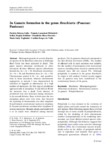Use este identificador para citar ou linkar para este item:
http://www.alice.cnptia.embrapa.br/alice/handle/doc/326409| Título: | 2n Gamete formation in the genus Brachiaria (Poaceae: Paniceae). |
| Autoria: | GALLO, P. H  MICHELETTI, P. L.   BOLDRINI, K. R.   RISSO-PASCOLOTTO, C.   PAGLIARINI, M. S.   VALLE, C. B. do   |
| Afiliação: | Patrícia Helena Gallo, UEM; Pamela Lonardoni Micheletti, UEM; Kellen Regina Boldrini, UEM; Claudicéia Risso-Pascotto, UEM; Maria Suely Pagliarini, UEM; Cacilda Borges do Valle, CNPGC. |
| Ano de publicação: | 2007 |
| Referência: | Euphytica, Wageningen, Holanda, v. 154, n. 2, p. 255-260, 2007. |
| Conteúdo: | Microsporogenesis of several Brachiaria species of the Brazilian collection at Embrapa Beef Cattle has been analyzed in detail. This paper reports abnormal cytokinesis in three accessions of three different species (Brachiaria humidicola, 2n = 4x = 36, Brachiaria decumbens, 2n = 4x = 36, and Brachiaria dura, 2n = 6x = 54). Chromosomes paired in bi-, tri-, and quadrivalents in these accessions, whereas chromosome segregation at meiosis I was characterized by exclusion of laggards as micronuclei. In a high number of meiocytes, the first sign of cytokinesis appeared only in metaphase II and did not divide the meiocyte into a dyad. Total absence of cytokinesis was also detected among meiocytes in the second division. Since in both cases the two metaphase plates were very close, they favored the rejoining of chromosome sets after anaphase II and formed a restitutional nucleus in telophase II. Second cytokinesis occurred after telophase II in most meiocytes. Monads, dyads, and triads with n or 2n nuclei were observed among meiotic products. The 2n gametes observed correspond to the first division restitution (FDR). The number of affected cells in each accession was variable, but the number of microspores with restitutional nucleus, including those scored in tetrads and the released ones, did not exceed 9%. Although polyploidy is common in the genus Brachiaria, its origin is still unclear. Current results suggest that 2n gametes may have contributed to the evolutionary history of the genus. |
| Thesagro: | Brachiaria Humidicola Brachiaria Decumbens Citogenética Vegetal Gramínea Forrageira Melhoramento Genético Vegetal Poliploidia Planta Forrageira |
| NAL Thesaurus: | Brazil cytogenetics polyploidy plant breeding |
| Palavras-chave: | Braquiária Brachiaria dura Campo Grande Mato Grosso do Sul Brasil Feed crops Feed grasses |
| Notas: | CNPGC. |
| Tipo do material: | Artigo de periódico |
| Acesso: | openAccess |
| Aparece nas coleções: | Artigo em periódico indexado (CNPGC)  |
Arquivos associados a este item:
| Arquivo | Descrição | Tamanho | Formato | |
|---|---|---|---|---|
| fulltext.pdf | 486,07 kB | Adobe PDF |  Visualizar/Abrir |









